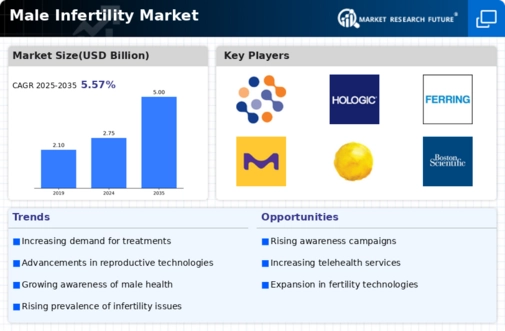Rising Incidence of Male Infertility
The prevalence of male infertility appears to be on the rise, with estimates suggesting that approximately 15% of couples experience infertility issues, and male factors contribute to about 50% of these cases. This trend is likely to drive the Male Infertility Market as more individuals seek diagnosis and treatment options. Factors such as environmental pollutants, lifestyle choices, and increasing stress levels may contribute to this increase. As awareness grows, healthcare providers are more inclined to address male infertility, leading to a surge in demand for fertility treatments and services. Consequently, the Male Infertility Market is expected to expand as more men seek assistance in overcoming infertility challenges.
Increased Investment in Fertility Research
Investment in fertility research is gaining momentum, which may have a profound impact on the Male Infertility Market. Governments and private organizations are allocating substantial funds to explore the underlying causes of male infertility and develop innovative treatment options. This influx of funding is expected to accelerate the pace of research and development, leading to breakthroughs in understanding male reproductive health. As new findings emerge, the Male Infertility Market could see an increase in the availability of effective treatments and therapies, ultimately benefiting those affected by infertility.
Growing Acceptance of Male Fertility Testing
The growing acceptance of male fertility testing is likely to reshape the Male Infertility Market. Traditionally, infertility has been viewed as a female issue, but there is a noticeable shift towards recognizing male contributions to infertility. This change in perception encourages men to seek testing and treatment options, thereby increasing the demand for male fertility services. As awareness campaigns and educational initiatives proliferate, more men are expected to engage in proactive health measures, further propelling the Male Infertility Market forward.
Focus on Holistic Health and Lifestyle Changes
There is an increasing focus on holistic health and lifestyle changes that may positively influence male fertility. The Male Infertility Market is responding to this trend as more individuals adopt healthier lifestyles, including improved diets, regular exercise, and stress management techniques. Research indicates that lifestyle factors can significantly impact sperm quality and overall reproductive health. As men become more aware of the connection between lifestyle choices and fertility, the demand for related products and services is likely to rise, thereby enhancing the growth potential of the Male Infertility Market.
Advancements in Assisted Reproductive Technologies
The Male Infertility Market is significantly influenced by advancements in assisted reproductive technologies (ART). Techniques such as intracytoplasmic sperm injection (ICSI) and sperm retrieval methods have revolutionized the treatment landscape. Data indicates that ART procedures have increased in popularity, with millions of cycles performed annually. These innovations not only enhance the chances of conception for couples facing male infertility but also improve overall success rates. As technology continues to evolve, the Male Infertility Market is likely to witness further growth, driven by the introduction of new techniques and improved outcomes for patients.


















Leave a Comment